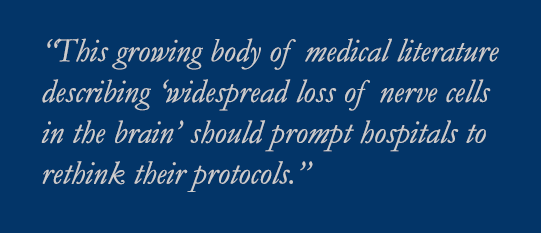Anesthesia when administered properly has over the years been a resounding success, enabling surgical and other complex procedures to be performed routinely that otherwise would not be possible. Indeed, it’s difficult to think of modern medicine without thinking of the vital role that anesthesia has played.
In recent years, there’s been one aspect of anesthesia that has garnered growing attention—its use in children. There’s a growing body of medical literature that has identified the neurotoxicity of general anesthesia in children younger than three years of age.
On December 14, 2016, the FDA made the following announcement: “The U.S. Food and Drug Administration (FDA) is warning that repeated or lengthy use of general anesthetic and sedation drugs during surgeries or procedures in children younger than 3 years or in pregnant women during their third trimester may affect the development of children’s brains.”
The announcement continued: “Published studies in pregnant animals and young animals have shown the use of general anesthetic and sedation drugs for more than 3 hours caused widespread loss of nerve cells in the brain. Studies in young animals suggest these changes result in long-term effects on the animals’ behavior or learning (see Data Summary). Studies have also been conducted in children, some of which support findings from previous animal studies, particularly after repeated or prolonged exposure to these drugs early in life.”[1]
A recent online article published in the New England Journal of Medicine states: “At the 2014 meeting, the publicly available preclinical and clinical data were presented by representatives of the FDA. The data from studies in animals and in vitro research demonstrate that under experimental conditions, all general anesthetics tested, including both N-methyl-d-aspartate (NMDA) antagonists and gamma-aminobutyric acid (GABA) agonists, have immediate neuroanatomical consequences and associated long-lasting, if not permanent, functional effects in species ranging from roundworms to nonhuman primates.”[2]
presented by representatives of the FDA. The data from studies in animals and in vitro research demonstrate that under experimental conditions, all general anesthetics tested, including both N-methyl-d-aspartate (NMDA) antagonists and gamma-aminobutyric acid (GABA) agonists, have immediate neuroanatomical consequences and associated long-lasting, if not permanent, functional effects in species ranging from roundworms to nonhuman primates.”[2]
The authors pointed out: “At Texas Children’s Hospital, where anesthesia is administered in more than 43,000 cases each year, approximately 13,000 of these cases involve patients under 3 years of age, and about 1300 of these patients undergo anesthesia for more than 3 hours; two thirds of these cases of prolonged anesthesia are for procedures related to congenital heart disease. Essentially all these prolonged procedures are for serious or life-threatening congenital conditions for which there are no alternative treatments and for which treatment cannot be delayed until the patient reaches 3 years of age.”
Yet another recent article concluded: “The results of this study suggest that sugammadex coadministered with neonatal sevoflurane exposure enhances neuronal apoptosis. Exposure to 2% sevoflurane for 6 h resulted in BBB [blood brain barrier] ultrastructural abnormalities in the hippocampus of neonatal mice.”[3]
This growing body of medical literature describing “widespread loss of nerve cells in the brain” should prompt hospitals to rethink their protocols. The question to be asked––Does the risk of anesthesia outweigh the benefits of the procedure contemplated?––should in each case be discussed. There’s no question that, with regard to children three years or younger, if it’s possible for a procedure to be safely postponed, it should be. Otherwise in those instances where a procedure is emergent or otherwise required due to a life-threatening condition, informed consent must be given.
The more pressing problem is to devise a form of anesthesia that’s safe for children––one that’s not neurotoxic to a child’s developing brain. (Is this an area currently being researched? If not, it should be…) Another approach is to devise safe ways of performing invasive procedures without using anesthesia for pain control. The best approach, of course, is preventive––finding ways to prevent the conditions that require the use of anesthesia in children before they occur.
[1] FDA Drug Safety Communication: FDA review results in new warnings about using general anesthetics and sedation drugs in young children and pregnant women (December 14, 2016)
http://www.fda.gov/Drugs/DrugSafety/ucm532356.htm
[2] Dean B. Andropoulos, M.D. and Michael F. Greene, M.D., Anesthesia and Developing Brains — Implications of the FDA Warning (February 8, 2017)
http://www.nejm.org/doi/full/10.1056/NEJMp1700196?query=featured_home
[3] Maiko Satomoto, Zhongliang Sun, Yushi U. Adachi, Koshi Makita, Sugammadex-Enhanced Neuronal Apoptosis following Neonatal Sevoflurane Exposure in Mice, Anesthesiol Res Pract. 2016; (November 8, 2016)(doi: 10.1155/2016/9682703)
https://www.ncbi.nlm.nih.gov/pmc/articles/PMC5118529/




